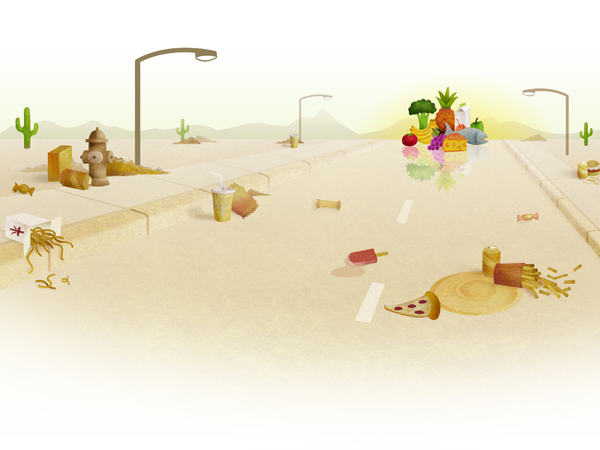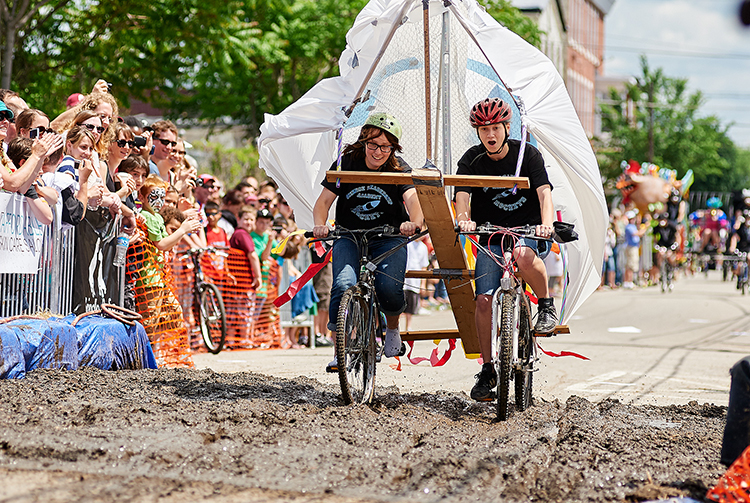 North Philly still lacks fresh food access
North Philly still lacks fresh food access
by Tenaya Darlington
Kensington, one of Philadelphia’s poorest neighborhoods, has undergone significant revitalization over the last few years, especially along the southern corridor that borders Northern Liberties. You’ll now find a coffee shop, a Spanish imports store and even a sustainable fish merchant amid the tattoo parlors and check cashing stores that dot Girard Avenue between Front Street and 5th, the loosely defined borders of what neighbors call “South Kensington.” Keep moving north, though, toward Cecil B. Moore Avenue, and you’ll find yourself in something of a nutritional wasteland.
“I definitely have to leave the neighborhood to find good produce,” says Delma Montanez, who has lived in the area for the last four years. On a Wednesday afternoon in late October, she’s at her desk compiling a list of money-saving grocery tips for the newsletter put out by the Kensington South Neighborhood Advisory Council (KSNAC), which serves neighbors between Berks and Front streets, and Frankford Avenue to Sixth. “Got any ideas, other than clipping coupons and shopping the sales?” she asks.
Montanez, who serves as Program Coordinator for the KSNAC, believes that grocery access “is a crisis” for her neighborhood. She’s checked out all the markets in and around Kensington—half a dozen or so “discount stores” grouped around fast food chains that mostly flank Lehigh and Aramingo—and reports, “We have to avoid the discount-store syndrome, because you’re not always going to get the best prices.” Or find quality produce.
Montanez says many of her neighbors drive to Trader Joe’s in Center City or shop at the Thriftway in Port Richmond. She drives to the Manayunk Farmers’ Market, favoring the fresh selection, and makes weekly trips to the large ShopRite outside her neighborhood at 3745 Aramingo.
You might wonder: Is all this travel really necessary?
Take a tour of Kensington’s grocery stores sometime. At the clean, bright Save-A-Lot at 2132 E. Lehigh, the rack of baked goods by the registers is almost the same size as the produce case, which features a limited but robust-looking supply of tomatoes, collards, peppers and other staples. Except for these offerings, just about everything else in the store is pre-packaged, including a cheese case limited to processed singles and a large stand-alone cooler of 99-cent bologna. Amid the hundred or so loaves of white sandwich bread, there’s only one wheat loaf.
At Cousin’s, a dimly lit store at 3rd and Lehigh, with scuffed floors and saggy streamers draped between the aisles, you’ll find rows of doughnuts lined along the butcher case when you enter. Nearby, a limited selection of produce—malanga, whole tamarind pods, plantains, mangos—shares the aisle with a multi-door ice cream freezer full of frozen desserts. A giant pallet of off-brand soda, still partially shrink-wrapped, sits by the registers. Just about everything here, as with Save-a-Lot, is canned, frozen or pre-packaged.
The ShopRite that Montanez frequents is at least three times the size of these stores and offers a wide selection of produce (even a few organic items), but it’s miles from home. So, if you don’t have a car to drive out to one of these main shopping arteries, how do you shop in Kensington at all?
This question was the subject of a grocery study commissioned by the Food Trust, a Philadelphia-based nonprofit, back in 2001. It documented the gross inequity in the number of grocery stores across the city and revealed that Philadelphia had the second lowest number of supermarkets per capita of major cities in the United States. Low-income neighborhoods, such as Kensington, were found to contain 156 percent fewer stores than in high-income neighborhoods. The study also found a correlation between lack of grocery access and diet-related diseases, such as diabetes and obesity.
“In Center City, you’ve got Reading Terminal and several supermarkets,” offers David Adler, the Food Trust’s former Communication Director, “and you compare that to areas of North Philadelphia, where you’ve got mostly corner stores that stock canned goods and snack foods. If you don’t have a car and there isn’t a grocery store within half a mile of where you’re living, can you get fresh food?”
Since 2001, the Food Trust has helped roll out some groundbreaking endeavors, including the Fresh Food Financing Initiative, which has committed $67 million dollars in funding to support supermarket projects around the state.
The initiative has supported entrepreneurial businesses like Greensgrow, a nonprofit urban farm in Port Richmond that grows and sells organic produce. Elsewhere in North Philly, the initiative has helped finance an outpost of Weaver’s Way Co-op on Ogontz Avenue (at 72nd Street), and helped a small market in Juniata Park—Romano’s Grocery—buy energy-efficient refrigerators. Romano’s now carries everything from greens and avocadoes to grapes and berries.
There’s also a Fresh Grocer in the works for Progress Plaza on North Broad Street, just below Cecil B. Moore, that’s expected to open sometime this year.
But where does that leave Kensington?
Sarah Corlett of the New Kensington Community Development Corporation (NKCDC) has high hopes for a new grocery venue along Frankford Avenue, which is slated for improvement as part of a $3 million streetscape program. “There’s a group of East Kensington neighbors that’s looking to start a food co-op,” she says. “People would love to have something around the corner they could walk to.”
Kensington native Kathy Bannan remembers when her family did all their shopping in the neighborhood. “Growing up,” she says, “we only shopped at corner stores, because we could keep a tab. We’d buy our meat from the corner butcher, you know. I never went to a grocery store until I got married.”
Today, small mom-and-pop-run corner stores still dot the neighborhood, appearing every few blocks. Most of them carry the same products: soda, chips, candy, canned goods, and coolers of Dietz & Watson cold cuts for making hoagies. Few of them, other than the new Cornerstone Market near Frankford and Girard, carry anything more exotic than an onion and maybe a few oranges or apples.
In the afternoons, corner stores around Kensington are hopping with school children, munching Flamin’ Hot Cheetos and sipping cartons of Arctic Splash. Andrew Judd, a graduate student in social work at the University of Pennsylvania, has spent a lot of time standing outside corner stores and talking to elementary school kids in and around Kensington about their shopping habits—it’s part of his internship with the Food Trust. “We’ve found that kids spend on average two dollars a day at corner stores, which amounts to about six hundred calories,” he says.
In an effort to promote healthy options for kids who shop at corner stores, the Food Trust came up with a plan to provide “fresh fruit barrels”—stand-alone coolers filled with containers of fresh fruit—to a dozen corner stores, including two in West Kensington: Diogenes Grocery (at Lawrence and York) and Tarina’s Food Market (at York and Orianna). In September of ’08, Judd made his first fruit deliveries and stood back to watch.
“We started with 25 containers at each store—each one costs a dollar,” Judd says. Within the first week, all of the stores sold out. “Today, many stores are ordering 75 or a hundred.”
That’s proof, in Judd’s mind, that the “food desert,” as he calls it, is beginning to blossom.


